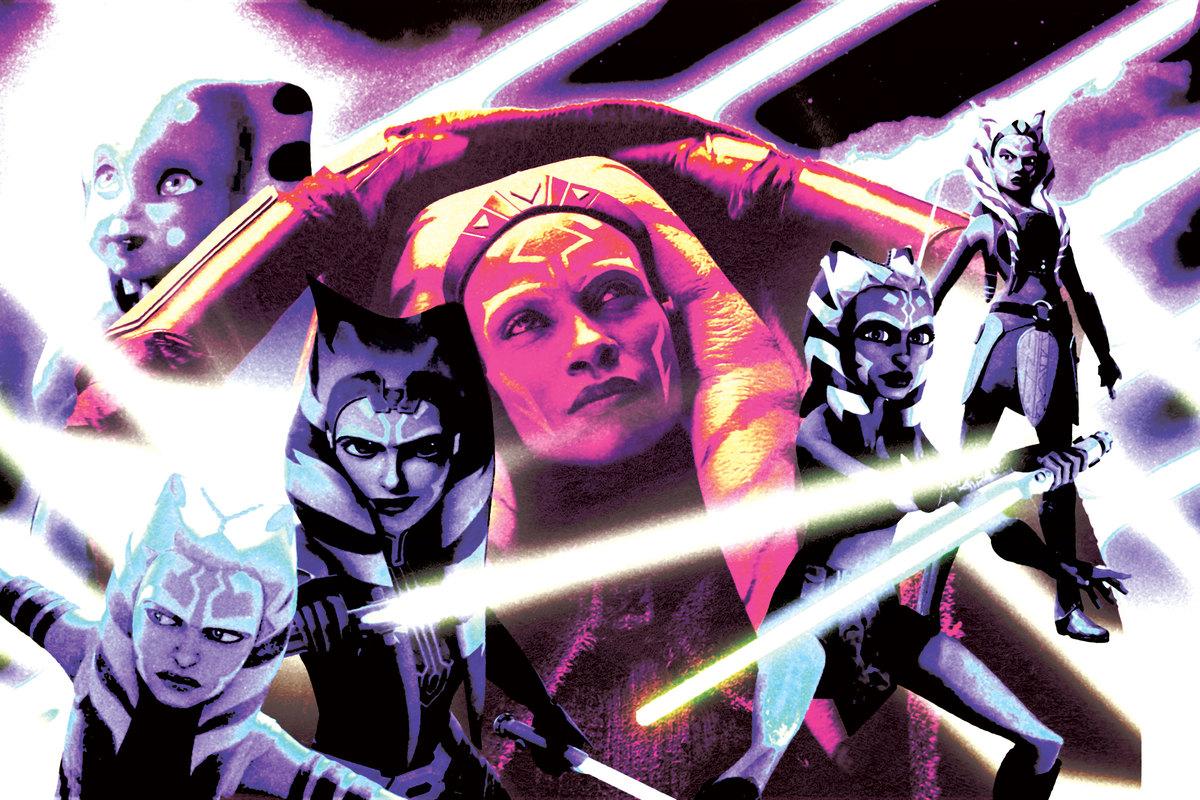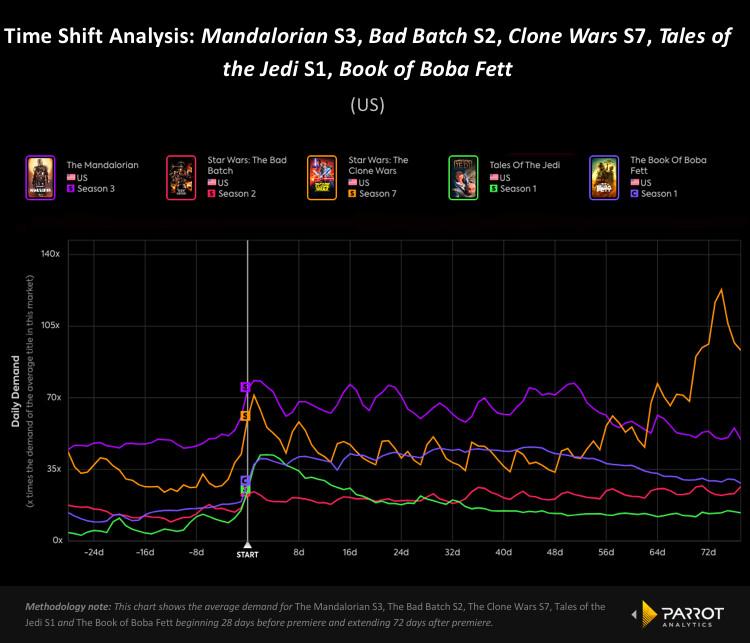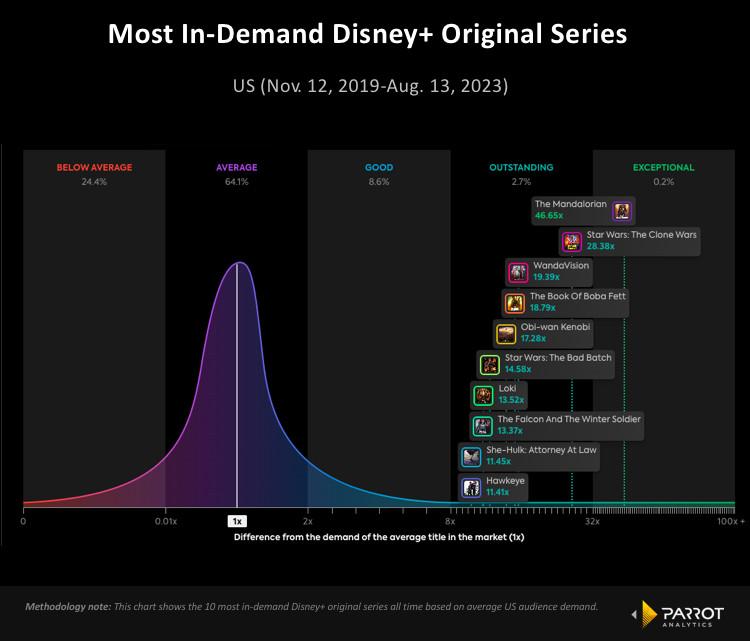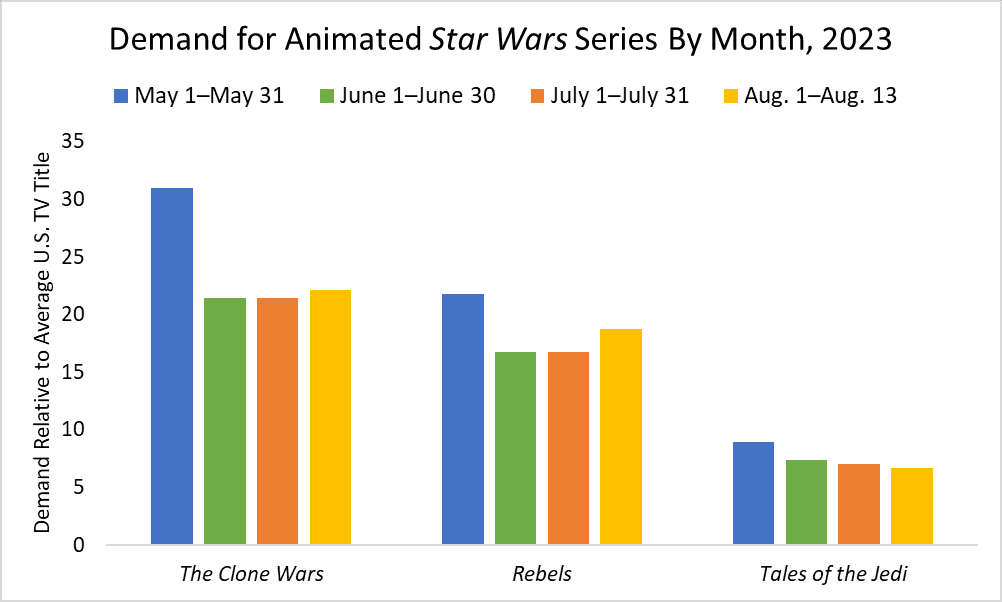Can ‘Ahsoka’ Be the Fulcrum of the ‘Star Wars’ Franchise?
An audacious attempt to bring animated favorites to a live-action connected universe, the ‘Ahsoka’ experiment reflects the state of ’Star Warsu003cemu003e.u003c/emu003e’u003cemu003e u003c/emu003eIts level of success may help determine the wider franchise’s future.
Star Wars started as a movie franchise, and for 45 years, its TV tendrils ensnared audiences by referencing the franchise’s big-screen roots. The Star Wars Holiday Special opened on Han Solo and Chewbacca. Ewoks led with Wicket, and Droids with C-3PO and R2-D2. Decades later, The Clone Wars kicked off with a scene featuring Yoda and Count Dooku. Rebels began with Darth Vader, and Resistance name-checked Poe Dameron in its second line. The Bad Batch’s intro incorporated characters from the prequels, and Young Jedi Adventures gave Yoda its first speaking part. The Mandalorian, more committed than most to blazing its own trail, still launched on Disney+ with a premiere featuring core characters who could’ve been confused for Boba Fett, IG-88, and Yoda. The live-action trio that followed—The Book of Boba Fett, Obi-Wan Kenobi, and Andor—revolved around figures from the films. With few exceptions, Star Wars TV series start by reassuring fans who associate Star Wars with the big screen that they’re in the right place.
Not so with Ahsoka, the latest addition to Lucasfilm’s Star Wars portfolio. Ahsoka’s two-part premiere, which will start streaming on Tuesday night, doesn’t draw deeply on any theatrical releases (unless you count The Clone Wars, the 2008 animated movie that grew out of and set up the series). Ahsoka is something new: a Star Wars TV series that owes its existence almost solely to the legacy of previous Star Wars TV series. And not just any previous Star Wars TV series: animated series, specifically. Ahsoka is audacious in a few respects: its integral ties to earlier small-screen shows, its dependence on characters ported from animation to live action, and its reliance on a nonhuman lead character (who, in another first for a central Star Wars protagonist, is played by a nonwhite woman—one of three women at the top of the call sheet). Ahsoka is an experiment that reflects the state of Star Wars—and its level of success may help determine the franchise’s future.
Ahsoka was created, written, and sometimes directed by Dave Filoni, the protégé of George Lucas who’s carried the franchise’s flame since Lucas sold his creation to Disney in 2012. For more than a decade, Filoni’s influence was confined to Lucasfilm’s animated efforts, which he rose to oversee. He served as supervising director of The Clone Wars and three of the four seasons of Rebels, the latter of which he cocreated; he later created, but didn’t regularly write for or direct, Resistance and The Bad Batch, in addition to creating and supervising Tales of the Jedi. In recent years, Filoni has leaped into live action alongside Jon Favreau, with whom he’s executive-produced The Mandalorian, The Book of Boba Fett, and Ahsoka, as well as the upcoming Skeleton Crew. He’s also making a movie. These days, Filoni has a hand in almost every Star Wars project, whether in an advisory role or as part of a creative tag team. But Ahsoka is clearly his baby, and his knowledge of and attachment to its characters drove him to write every episode.
Those characters are special to some Star Wars fans, too. The Clone Wars, which originally ran from 2008 to 2013 on Cartoon Network with a 2014 addendum on Netflix, and Rebels, which debuted later in 2014, bridged the gap between the prequel and sequel trilogies. The current lull between movies is packed with TV: Ahsoka will be the fourth of five Star Wars series to air on Disney+ this year, if Skeleton Crew’s previously announced late-2023 premiere isn’t postponed. With weeks or months between new shows, there’s a limit to how much any single series can shape the Star Wars experience. If you wanted new on-screen Star Wars stories during the decade between Revenge of the Sith and The Force Awakens, though, Filoni’s were what you watched. Compared to today’s content torrent, those shows were drip feeds, but the relative scarcity of Star Wars at the time made them loom larger in many fans’ minds.
For the most part, Filoni’s first two shows didn’t disappoint. Although The Clone Wars’ lengthy seasons contained their share of forgettable episodes, especially early in its run, much of the series’ storytelling and character development made the prequels seem amateurish by comparison. Rebels was riveting from the start, proving that new Star Wars projects could capture the classics’ appeal under Disney’s stewardship. Their combined catalogs amounted to more than 200 episodes, and fans who put in the time to watch them all couldn’t help but be invested in the relationships that formed, flourished, and fractured throughout their runs. It would take a tad more than a day to marathon all 11 live-action Star Wars movies. It would take more than four days of nonstop streaming to see all of The Clone Wars and Rebels.
Thus, for many fans who came of age during the cinematic interregnum of the late 2000s and early 2010s—following the generation that has spearheaded a 2020s wave of prequel nostalgia—those animated series are Star Wars, as much as or more than the movies. “I made a series of movies that was about one thing: Darth Vader,” Lucas once said of his two trilogies. Yet The Clone Wars boasts what may be the most sympathetic and poignant portrayal of Lucas’s Chosen One, and the primary reason for the animated Anakin Skywalker’s unparalleled appeal is his contentious but caring relationship with his Padawan, Ahsoka.
Ahsoka isn’t just a foil for Anakin, either: She’s one of the Star Wars saga’s richest characters in her own right. Viewers of the various animated series have grown up with Ahsoka as she’s morphed and matured from precocious infant to spunky, tube-top-wearing teen to capable apprentice to disillusioned lone wolf to Rebel leader to Gandalf-inspired itinerant teacher and master. “I hope through Ahsoka we showed fans that the universe has many possibilities,” Filoni said in 2018. After 15 years, the universe of Ahsoka is still expanding at light speed.
In fact, it’s expanded so much that it’s tough to catch up on the back catalog. As Filoni has acknowledged, the “biggest challenge” in creating Ahsoka was reckoning with viewers’ varying awareness of its eponymous character. As Filoni put it, “There’s a whole bunch of audience that know her and a whole bunch that don’t.” Of course, Ahsoka herself is familiar to, if not beloved by, a live-action audience thanks to her hyped interactions with Din Djarin, Grogu, and Luke Skywalker in The Mandalorian and The Book of Boba Fett. Those crossover visits, plus her vocal cameo in The Rise of Skywalker and prominent roles in 2020’s final season of The Clone Wars and last year’s Tales of the Jedi, have given viewers ample prodding to get up to speed on Ahsoka. Ahsoka’s non-titular leads and supporting cast—including Hera Syndulla, Sabine Wren, Ezra Bridger, and Grand Admiral Thrawn, as well as leading droids Huyang and Chopper—are even less familiar to fans who’ve consumed Star Wars solely through live-action film and TV.
It’s tough to assess what that might mean for Ahsoka’s reach. Like most streamers, Disney isn’t transparent about its audience size, and the original runs of The Clone Wars and Rebels predate Disney+. We can get some sense of the respective levels of interest in recent live-action and animated Star Wars seasons through Parrot Analytics’ “demand” metric, which synthesizes data on consumption, social media engagement, and search queries to produce a demand figure relative to the average U.S. TV title. The table and graph below tell a semi-consistent story, with one notable exception.
Demand Relative to Average U.S. TV Title

“Overall, the live-action series tend to perform better than the animated series,” Brandon Katz, Parrot’s entertainment industry analyst, says via email. The average demand for The Bad Batch, Tales of the Jedi, and Visions Season 2 from their premieres to finales ranked below Andor’s (sadly, the least in-demand live-action show). However, the final season of The Clone Wars exceeded the average demand of any other series except The Mandalorian—and its peak demand was unmatched.
“The Clone Wars (orange line) reached a peak U.S. demand of 122.8x on May 5, 2020, the day after its series finale, which bested all the other seasons in the analysis,” Katz writes. “This may be due to the fact that none of the other ongoing/recent series have had the opportunity for an eventized concluding chapter. The Clone Wars’ longevity—having premiered in 2008—also may have played a role in the leadup to its finale.” The Clone Wars also ranks second (again behind The Mandalorian) on the list of the most in-demand original series since Disney+ launched in late 2019, though its 133-episode library probably drives up its placement in that metric relative to shows with far fewer installments.

Three live-action Star Wars series show up on that second graph, compared to two animated series. It’s possible, then, that while new animated shows typically have trouble keeping pace with new live-action shows, Ahsoka’s deeper roots and wide exposure across several series could give her spinoff (of The Mandalorian, Rebels, or both) a big built-in audience. And her popularity may help pave a path into live action for Ahsoka’s other returning Rebels characters and original characters, much like legacy characters such as Anakin, Obi-Wan, and Padmé helped establish Ahsoka when The Clone Wars debuted.
For now, though, there’s understandably a divide in familiarity with—and, perhaps, excitement for—the content of Ahsoka between Filoniverse fans and live-action-only fans. One could understand why those in the latter group might be intimidated by the prospect of studying for an eight-episode series (however pleasant Star Wars homework might be). To fully prepare for Ahsoka would require compressing 15 years of media into a rigorous regimen of Star Wars viewing and reading: start-to-finish binges of The Clone Wars and Rebels; selected episodes of Tales of the Jedi, The Mandalorian, and The Book of Boba Fett; and a dozen or more novels about Thrawn, Ahsoka, and the core cast of Rebels. Even abridged viewing guides call for hours of “research.” Star Wars fans who are coming in cold where Ahsoka and Co.’s backstories are concerned may be more in the market than usual for video or podcast primers.
Despite the daunting (but rewarding) lore library that awaits would-be Ahsoka scholars, the series has certainly served as an impetus for some Star Wars fans to dip or dive into Filoni’s animated oeuvre, thereby reinforcing the foundation of the franchise. What sets Star Wars apart from an IP perspective, Katz says, is that “it’s not just a sprawling story introducing new characters and connecting story lines. It’s the franchise’s ability to deploy these elements when exploring new mediums, formats, distribution networks, etc. The methodical construction that has boosted subsequent projects as a result, while driving interest back to the original titles, is one of the most effective in Hollywood.”
Now it’s Ahsoka’s turn to pay her popularity forward. “The fact that she’s grown so big that she can now anchor her own live-action series, which will also serve as the live-action debut of Ezra, Thrawn, etc., puts the exclamation point on this flywheel Star Wars has created,” Katz says.
There are some retrospective signs that developments in live-action Star Wars content can boost the appetite for animation, and vice versa. The week Ahsoka made her Mandalorian debut, midway through the series’ second season, average U.S. audience demand for The Clone Wars and Rebels increased 49 percent and 37 percent, respectively, compared to the previous week. The week she appeared in the penultimate episode of The Book of Boba Fett, demand for those series spiked 43 percent and 22 percent, respectively, compared to the previous week. And the week Tales of the Jedi premiered, U.S. demand for Ahsoka—which was then still a long way away—climbed from 1,198th among all titles to 549th.
On the other hand, Parrot’s stats haven’t shown a clear upward trajectory in demand for Ahsoka-adjacent animated series in the months leading up to the series premiere—the sort of surge that could indicate live-action-only holdouts are boarding the animation back-wagon in anticipation of Ahsoka. Demand spiked in May, likely because of Star Wars Day, and has been fairly flat since. Evidently, most fans either prepped well in advance or opted not to.

In the apparent absence of a mass uptick in interest in the animated series, Katz says Disney is betting that “live-action appearances across two shows, multiple Empire magazine covers, and more TV spots than usual thanks to the strike-induced lack of talent promotion can penetrate the more casual Star Wars fans. We shall see.”
For fans of Ahsoka and Rebels, this series seems like pure wish fulfillment—a close equivalent to Rebels Season 5, theoretically enhanced by human performances and big-budget effects. Star Wars fans who are squarely in the target demo for Ahsoka can rejoice in its existence without worrying about whether everyone else is on board. This fictional universe is so expansive that there’s no need for every Star Wars series to be built for every Star Wars fan. In fact, it’s probably better that some series be specific enough not to vibrate at every fan’s frequency.
That said, strong streaming numbers would bode well for Ahsoka, Sabine, Hera, and the rest of their friends and foes: Ahsoka could be the world between worlds of Star Wars TV, but the future of the franchise rests in the hands and head-tails of one Togruta non-Jedi. In the documentary Disney Gallery: The Book of Boba Fett, Filoni cited his and Favreau’s philosophy of “making this feel like one big, connected galaxy. That’s what Star Wars is. Where all the stories come together.” Season 7 of The Clone Wars was one superb example of Filoni’s connective narrative tissue binding the Star Wars galaxy together. Ahsoka has the potential to be another as Filoni and Favreau continue to use their small-screen canvas to lay the groundwork for the First Order. As Filoni noted in one of Empire’s stories, Ahsoka “has one foot in the Star Wars that a lot of people know because of her connection to Anakin, and yet she’s all new and can go in her own direction, in her own way. I think that makes her an interesting bridge between what came before and what’s really possible.”
The movies will always be the wellspring of Star Wars—the original source from which all subsequent stories flowed. But it’s been almost four years since the last Star Wars movie—which left the film franchise in acrimonious, rudderless ruins—and the next, still-unspecified movie isn’t due out until May 2026. Next year’s The Acolyte will train the Star Wars spotlight on a period roughly a century before The Phantom Menace, but for the foreseeable future, the Mandoverse is the franchise’s flagship setting—and the reception to Ahsoka may determine what part she and her associates will play in what comes next.
What with the success of The Super Mario Bros. Movie, Across the Spider-Verse, and TMNT: Mutant Mayhem, 2023 has been a big year for mainstream animation, both financially and artistically. It’s a triumph of a different kind that some streamers are betting big on live-action adaptations of animated tales—a genre with, at best, a mixed track record. But that’s not quite what Disney is doing. It’s difficult to come up with a comp for what Filoni, Favreau, and Lucasfilm president Kathleen Kennedy are attempting to pull off: They’re trying to integrate a vast cast of animated characters who have their own extensive stories into an adjacent and sprawling live-action universe. Not as supporting players—a practice used in the second and third seasons of The Mandalorian, which was itself somewhat divisive—but as standard-bearers. If this gambit works, it could unite two enormous, heretofore loosely connected clusters of Star Wars fans. If it backfires, it could derail Disney’s plans for a climactic crossover.
We last saw Ahsoka on-screen in the first-season finale of Tales of the Jedi, when Bail Organa asked her, “Are you sure you are ready to get back into the fight?” Naturally, she nodded. Anakin’s former apprentice was up to the task of helping Bail build a rebellion that could topple the Empire and end a galactic conflict, but the fight she’s facing now is also an existential struggle. Ahsoka excelled as a Fulcrum for the Alliance; her new assignment is to be a fulcrum for the franchise.


